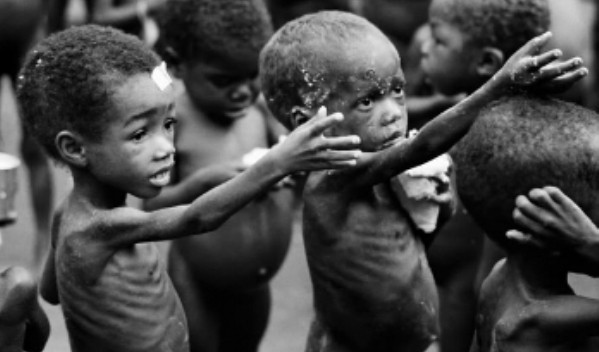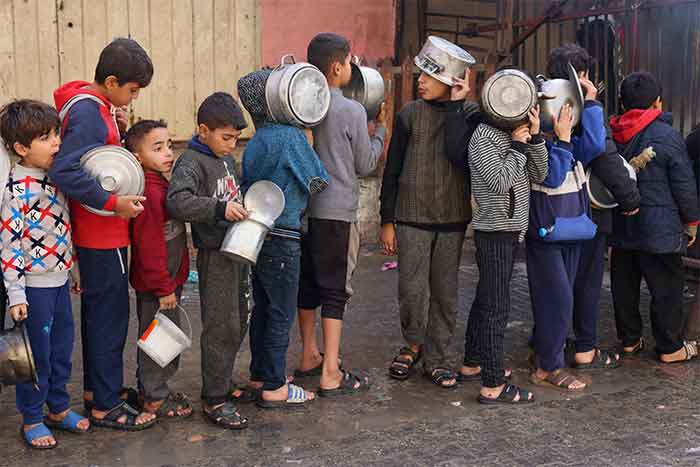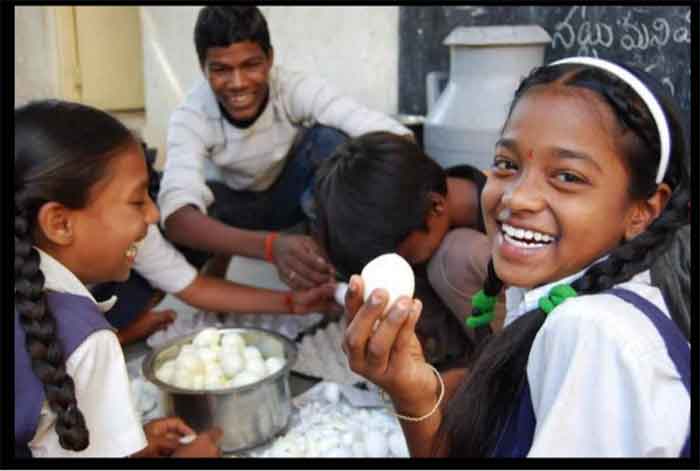
In a recent report ( March 2023) the World Food Program (WFP) stated that hunger in the world is at higher levels compared to any other time since the creation of the WFP in 1963. This report stated that 350 million people are affected by the most extreme form of hunger and 49 million are on the brink of famine. Climate crisis, conflicts and rising costs are identified as the three main causes of this extreme hunger crisis in this report.
This report has identified 10 countries to be most seriously affected by extreme hunger ( in fact the countries included in this list are 14 but are listed as 10 due to five Sahel countries being grouped together). These ten countries and regions are —Afghanistan, Yemen, Syria, Haiti, Democratic Republic of Congo, Sudan, South Sudan, Somalia, Ethiopia and the Sahel region (including the countries of Niger, Chad. Mali, Burkina Faso and Mauritania). Anyone familiar with the recent history of these countries would also testify that big power intervention and western imperialism have also contributed much to the destruction and hunger of these countries, although this is not mentioned in the WFP report.
It is clear from this report as well as several other reports that the most serious hunger is highly concentrated in the continent of Africa. It is deeply worrying that the conflict and instability situation has worsened in some parts of Africa in recent times. We cannot forget that within recent decades a very large number of famine deaths have been reported from parts of Africa and so there is clearly need for monitoring the situation very carefully ad ensuring large-scale relief well before this stage is reached.
The World Commission on Environment and Development (1987) noted that during the period October 1984 – April 1987 the ‘drought triggered, environment-development crisis in Africa peaked, putting 35 million people at risk, killing perhaps a million As the drought receded, some 19 million people continued to suffer famine.”
“Malnutrition and hunger have weakened much of the population, reducing their productivity, and made most of them (especially children and the old) more susceptible to debilitating diseases and premature deaths. The crisis has reversed progress in supplying safe drinking water and sanitation.”
It is shocking that one million persons could have died without an adequate response coming from the rest of the world or even definitive information reaching the concerned people of the world.
The Global Report on Food Crisis has been drawing attention to the people affected by acute hunger annually for seven years, and in year 2022 it presented estimates that 205 million spread over 45 countries are affected by acute food insecurity and need urgent assistance. To this were later added 17 million people from 8 other countries leading to a total of 222 million in 53 countries.
Subsequently in September 2022 the Food and Agriculture Organization and the World Food Program issued an update which presented the acute hunger outlook for the period October 22 2022 to January 23 2023. This report stated that in Tigray region of Ethiopia renewed conflict has increased the risk. Neighboring Amhara and Afar should be added to the high-risk situation. South-east part of Ethiopia is affected by fifth consecutive rain failure. In fact most of the entire Horn of Africa region has been affected by fifth consecutive rain failure or at least below normal rains. In Nigeria 19.5 million people are affected by acute food insecurity. Most of those in worst condition are in conflict- affected zones. Some—perhaps about one million people—are simply inaccessible to humanitarian organizations. Somalia is affected by fifth consecutive year of below normal rains, a situation worsened by conflicts. 6.7 million are affected by acute food insecurity, 2.2 million are in an emergency situation, nearly 300,000 face a catastrophic situation. South Sudan has experienced fourth consecutive year of flooding. In addition conflicts have added to the distress of people.
The high levels of debts of several of these countries and the austerity programs related to these have also resulted in increasing the distress of people. The international community has not been able to prioritize the distress of people in hunger hot-spots adequately. Enough resources for an adequate relief and rehabilitation effort have not been available. The Ukraine conflict has received the bulk of the attention of several potentially big donors, resulting in relative neglect of urgent needs of the countries and regions worst affected by acute hunger. Some of these countries were dependent on Ukraine and Russia for a substantial share of their supply of food and fertilizer, and this too has been adversely affected this year due to the Ukraine conflict.
A lot can still be done to salvage the situation, both in terms of stepping up the relief efforts as well as reducing/resolving conflicts. Debt waiving and relaxation of austerity programs will be helpful too. The most urgent need just now is to rush emergency relief assistance to people so badly affected by hunger and in real risk of starvation.
However on a longer-term basis it is also important to assess why farmers, pastorals and other people of Africa are finding themselves in such difficult and vulnerable conditions, where development priorities have gone wrong and what can be done to have the right priorities. A leading organization of farmers, pastoral people and rural communities of Africa has recently issued some important statements which deserve wider attention. This is AFSA, or Alliance for Food Sovereignty in Africa, which is a network of several networks, and its constituents have a reach to nearly 20 million rural people in various countries of Africa. The Program Coordinator of this organization, Bridget Mugambe has stated, “Today the majority of the solutions put forth and funded by governments and donors to address these problems are, in the long run, making things worse. Industrial agricultural methods, dubbed ‘climate smart agriculture’, promote the use of excessive chemical inputs on plants and in the soil, carbon credit programs are being developed to legitimize pollution and to uproot communities from their land. These are just a few examples of the false solutions brought by the rich and the powerful.”
Mugambe has emphasized that now the urgency for correcting past distortions and moving to agro-ecology has increased further due to climate change. To quote, “Africa is enduring the effects of climate change every day. It is time for both African and international leaders to listen to our demands and prioritize agro-ecology as an African-led solution to feed our communities while also adapting to climate change.” Dr. Million Belay, AFSA General Coordinator, has provided a message of even higher hope by stating, “ Africa could feed itself many times over. But agro-ecology cannot be and must not be overlooked by the decision makers as the most effective way to build resilience and enable small-scale farmers, pastoralists and fishers to adapt to climate change.”
This important viewpoint is also expressed in more detail in a position paper on ‘Adaptation, Resilience and Mitigation with Agro-Ecology’ and in a book ‘The Climate Emergency—How Africa Can survive and Thrive’, recently released by AFSA. The approach of AFSA is on the whole optimistic as it confidently asserts on the basis of its grassroots experiences that it is possible for African rural communities to not just survive but also thrive if only the right policy choices are made, backed by matching allocation of resources. These is need now for more respect for rich local biodiversity and traditional wisdom, which promoted in many fascinating ways the best use of scarce resources on the basis of a mutually protective relationship of settled farming and nomadic pastoral cultures.
On top of all this, however, there is overwhelming need for peace, conflict resolution and stability, as it is only in these conditions that sustainable and durable justice-based solutions for resolving the livelihood and food crisis in keeping with local needs and conditions can be found for all countries and regions of the troubled continent.
Hence a combination of policies based on justice, environment protection and peace is the way ahead for Africa, starting with a stepped up relief and food distribution effort which reaches even the most remote settlements.
Bharat Dogra is Honorary Convener, Campaign to Save Earth Now. His recent books include Planet in Peril, A Day in 2071 and India’s Quest for Sustainable Farming and Healthy Food.
















































